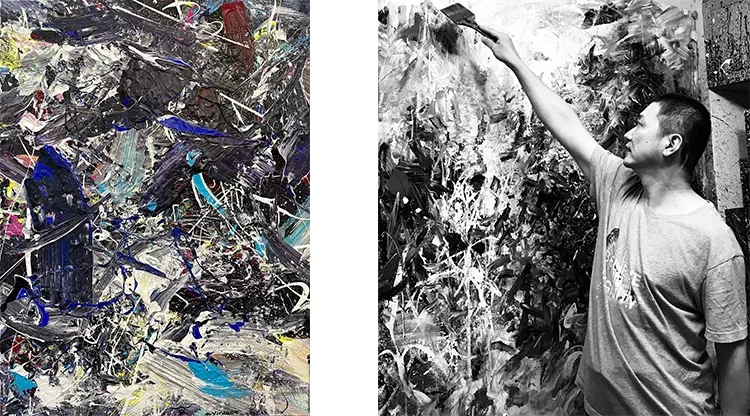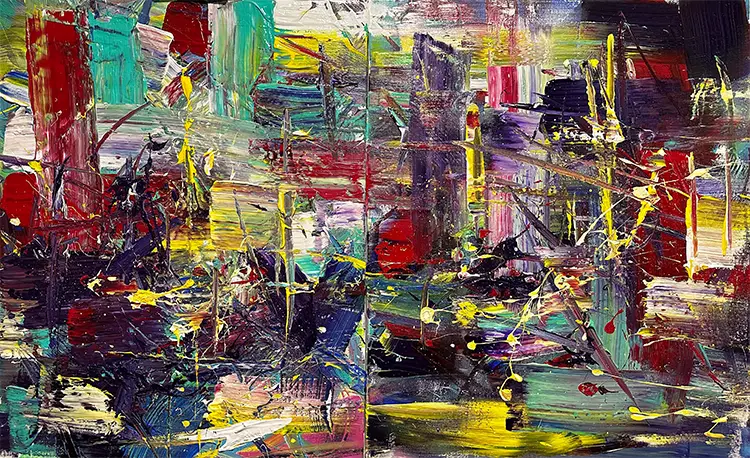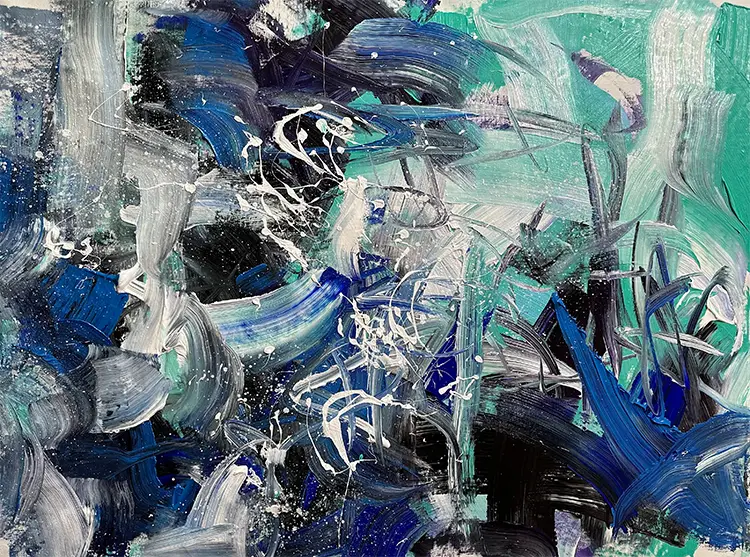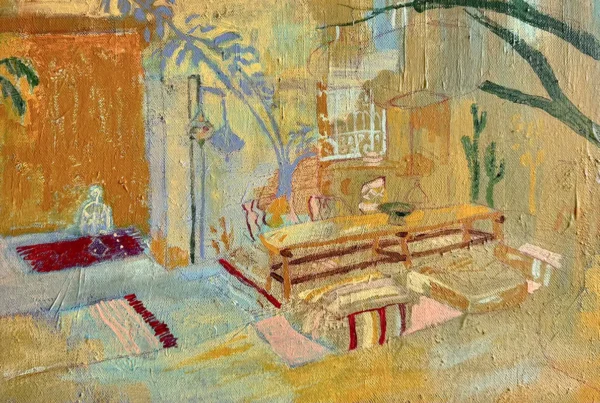“Abstraction is not an escape from reality; it is a deeper form of engagement.”
Memory as Resistance: Reclaiming Time in a Digitized Age
In a world increasingly dominated by rapid technological advancement and an unrelenting flow of information, Vincent Wang’s work offers a necessary deceleration. His art does not chase after speed or spectacle; instead, it holds space for introspection, urging viewers to pause and reengage with the slower rhythms of memory and spiritual presence. For Wang, painting is not merely a visual practice, but a meditative one—a process of revisiting the self and reflecting on the unseen architecture of time. Amidst a society where attention is fragmented and memory becomes unstable, his artistic practice strives to preserve a continuity of feeling, offering a rare space where temporal experience can be reconsidered, reclaimed, and made visible once more.
Themes of time and memory permeate Wang’s work, not as nostalgic references but as elemental forces that shape human perception. In the accelerated climate of modern existence, he sees a growing estrangement from these essential dimensions. Time, in his perspective, is not linear or abstract; it accumulates, seeps into consciousness, and lingers in the psyche. Through his use of layered textures, subtle tonal shifts, and spatial ambiguity, Wang crafts what he describes as “psychological time.” Every surface he paints becomes a site where memory sediment accumulates and spirit leaves its mark. The process itself resists the erosion of experience, proposing instead a renewed attention to the inner clock of human emotion and reflection.
What distinguishes Wang’s vision is his commitment to painting as a vehicle for reclaiming this inner life. His compositions do not strive for representation in the traditional sense, but rather evoke interior landscapes that hover between the seen and the felt. Each piece serves as a quiet dialogue between materiality and consciousness, bridging the fluid boundaries between time, thought, and perception. Through his meditative approach, Wang enables his viewers to witness time as something tangible—not a fleeting measure, but a resonant presence that invites contemplation and emotional immersion.

Vincent Wang: Inner Frequencies and the Language of Abstraction
For Vincent Wang, abstraction is not a stylistic choice but a profound philosophical stance. His work strips away surface distractions, inviting a deeper encounter with the emotional and spiritual undercurrents that often go unnoticed in daily life. Far from escaping reality, Wang sees abstraction as a more intense form of engagement—one that bypasses conventional representation to access what lies beneath. In this space of reduced form and intensified feeling, he finds the possibility of connecting to a shared human resonance. His belief in abstraction as a spiritual conduit stems from its capacity to engage viewers on a nonverbal level, awakening a subtle awareness that surpasses logic and language.
The abstract elements in Wang’s work function like vibrations, tuned to frequencies of emotion and introspection. By moving beyond literal imagery, he invites the viewer into a direct, unmediated experience—one shaped not by narrative but by sensation. Each composition becomes a kind of mirror, not of the external world, but of the viewer’s own internal landscape. Wang sees this as a necessary gesture in a time when external stimuli often overwhelm individual consciousness. His art slows the tempo, allowing space for a different kind of recognition, one rooted in spiritual clarity and quiet attentiveness. In this sense, abstraction becomes a form of care—an act of reaching toward the unspoken and the universally felt.
The universality of Wang’s visual language lies in its refusal to be fixed or decoded. Instead, it opens a porous space where viewers can bring their own experiences, memories, and emotional textures. His work honors ambiguity not as confusion but as openness—a soft kind of generosity that invites diverse interpretations. In our fragmented era, he believes this mode of expression is vital. It does not impose meaning but rather facilitates it, creating a shared ground where individual perception and collective feeling can overlap. Through this approach, Wang reinforces the idea that abstraction remains one of the most powerful tools for accessing the depth and subtlety of human experience.

The Unseen Conversation: Selfhood and the Social Gaze
Vincent Wang’s creative philosophy refuses any rigid divide between personal expression and collective resonance. Instead, he views these dimensions as fluid components of the same current. His process begins with introspection, with a deep immersion into his own emotional terrain, yet it unfolds in a manner that remains sensitive to the broader cultural and psychological currents of his time. Wang does not attempt to consciously balance the self with society; he allows their interaction to emerge organically within the act of creation. The result is work that speaks intimately while also remaining open to communal interpretation—a visual dialogue that invites viewers into a shared contemplation.
In Wang’s eyes, art is not a solitary monologue confined to the artist’s intent. It is an ongoing conversation, a responsive gesture that listens as much as it asserts. His compositions function as open-ended texts, shaped as much by the viewer’s perception as by the artist’s hand. This perspective aligns with his belief in art as a space of continual expansion, where meanings are not fixed but evolve through interaction. Each brushstroke carries both personal resonance and potential for collective insight, revealing layers that respond to both private emotion and public consciousness. In this dynamic tension, Wang finds the enduring power of visual language—a medium capable of reflecting the soul while engaging with the pulse of society.
Rather than presenting himself as a detached creator, Wang embraces vulnerability and connection as central to his artistic identity. His work is born from an introspective space but extends beyond it, creating a bridge between self and other, artist and viewer. By allowing his interior world to be shaped in response to external perception, he acknowledges the porous boundaries between individual subjectivity and shared cultural experience. In this exchange, his paintings achieve a rare kind of honesty—one that does not dictate interpretation, but encourages contemplation. Through this openness, Wang’s work becomes a site where the self is not isolated but encountered within a broader, more spiritual context.

Vincent Wang: The Artist as Listener in a Disoriented Age
Vincent Wang envisions the role of the contemporary artist not as a prophet or preacher, but as a careful observer of our collective condition. He resists the outdated archetype of the artist as visionary leader, choosing instead to approach his practice with humility, attentiveness, and philosophical curiosity. In his view, today’s most urgent artistic task is not to deliver grand solutions but to create spaces for reflection—spaces where the spiritual and emotional dimensions of life can resurface amidst the noise of contemporary existence. This shift marks a quiet revolution in Wang’s practice: the transformation of art into a space of resonance rather than instruction, of presence rather than persuasion.
In a world marked by ecological uncertainty, technological upheaval, and the disorientation of globalized living, Wang believes that art must offer something deeper than surface commentary. It should reintroduce qualities often lost in modern society—stillness, empathy, and the slow, deliberate act of seeing. He argues that the true power of visual art lies in its capacity to embody openness, warmth, and subtle resistance to the forces of speed and consumption. Through poetic form and intuitive gesture, his work seeks to restore a kind of spiritual equilibrium—one that does not shy away from the complexity of the times but responds with sensitivity and care.
Wang’s vision for the future of art emphasizes the intimate over the monumental, the inward gaze over spectacle. He imagines a creative landscape where artists serve not as cultural authorities but as facilitators of quiet insight. This evolution, he suggests, is not a retreat from social engagement, but a more reflective mode of participation—one that honors ambiguity, nurtures spiritual connection, and rebuilds a sense of shared humanity through subtle visual means. In this way, Wang’s work transcends the purely aesthetic, becoming a form of ethical and emotional stewardship in a disoriented world.






